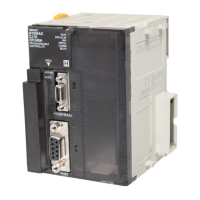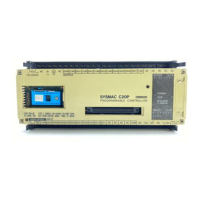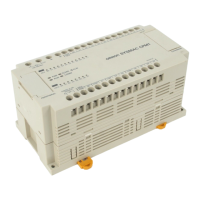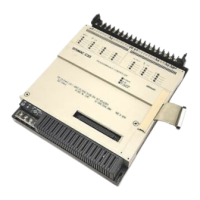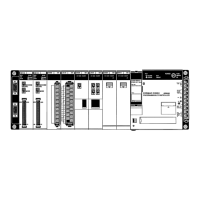8 9
Improved Support Software for an Integrated
Windows-based Development Environment
More efficient design and development using the CX-Programmer for programming
and network configuration, and CX-Simulator for operation simulation.
Middleware to Support PLC-centered System Construction
Easy development of user applications for communications with the new CS1.
CX-Simulator
CX-Simulator
CS1
CX-Programmer
(Programming
software)
CX-Simulator
(Virtual CPU Unit)
Windows
Online connection
Online connection
Integrated
development
environment
Inside the personal
computer
System PLC
CS1
CX-Programmer CX-Simulator
CX-Net Network Configuration Tool
Actual PLC
CS1
Sequential data
Virtual external
input
Virtual
CPU Unit
System status
setting window
Debugging console
window
Virtual
CPU Unit
Virtual
CPU Unit
Start
Stop
Network support: Controller
Link, Ethernet, or RS-232C
serial communications
CS1
Visual Basic user application
Compolet
Fins Gateway
Network board or port
Excel
PLC Reporter (Fins Gateway)
Network board or port
Network support: Controller
Link, Ethernet, or RS-232C
serial communications
Easier and more efficient design, developmen t, and maintenance with
Windows-based software and middleware.
The evolution of
the SYSMAC CS1 is
accelerating advances in
the production site.
Enhanced Efficiency for
Program Development Teams
(for CPU Unit Ver. 2.0 or Later)
Multiple programmers will enjoy better
efficiency when working on task-based
programs, thanks to automatic
checking for address duplication
among tasks, downloading and
uploading in task units, and easy
monitoring of task operating status.
Programs Can Be Executed,
Monitored, and Debugged
without an Actual PLC
Data Logging On-site and
Operation Verification in the
Office
SYSMAC Compolet:
Accessing the CS1 with
Visual Basic
Comprehensive Debugging
Functions Including Ladder
Step Execution and Break Points
The new CS1 has comprehensive
debugging functions, including ladder
step execution (execution by instruction),
start point settings, break point setting,
I/O break conditions, and scan execution.
This enables more detailed debugging
without using an actual PLC. Interrupt
tasks can be simulated, enabling more
realistic debugging.
Copy and Paste between
Spreadsheets and Symbol Tables
You can use your favorite spreadsheet
application to prepare an allocation
table with symbol names, addresses,
and I/O comments, then copy and paste
it into a symbol table, and also do the
reverse. This greatly improves
programming productivity.
The CX-Simulator Software simulates
ladder execution of the new CS1 CPU
Unit on a computer. Online functions,
such as monitoring of I/O bit status,
monitoring of I/O memory present
values, forced set/reset, differential
monitoring, data tracing, and online
editing, can be performed by connecting
to the virtual CPU Unit on the computer
from the CX-Programmer using the CX-
Simulator. This reduces the total lead
time to machine or system startup.
Use SYSMAC Compolet for
communications with OMRON PLCs to
greatly reduce development time of
user applications for CS1 I/O memory
read and write, forced set/reset, and
FINS message communications using
Visual Basic.
PLC Reporter 32:
Add-on Software for Accessing
the New CS1 Using Excel
Use PLC Reporter 32 to automatically
collect specific CS1 I/O memory data
into Excel 97 or Excel 2000 cells without
special programming. Basically, a
system can be constructed with a
computer, PLC Reporter 32, Excel, and a
host link cable. The cost of constructing
a monitoring system can thus be greatly
reduced.
Checking for address duplication among
tasks developed by multiple programmers is
automatically executed with the cross
reference report of CX-Programmer.
Download only the revised tasks.
The report shows that this
address is used in the
program in the right
column, and tells how
many times it is used.
CX-Programmer list of
duplicate addresses
The execution status of each task can be
monitored with CX-Programmer to improve
debugging efficiency.
Monitoring with
CX-Programmer
Task 1
Executing
Task 1
Executing
Task 1
Executing
When development is
done by several people,
only the tasks that have
been revised need to be
downloaded from CX-
Programmer.
Check for duplicate addresses
Sequential data from I/O memory in the
actual PLC can be obtained and saved
as a data recreation file (CSV format).
On-site PLC ladder execution can be
recreated on a computer by inputting
this data to the CX-Simulator as virtual
external input data.
OMRON FB Library
FB
What is the OMRON FB Library?
The OMRON FB Library is a set of functional objects for
ladder programming for OMRON CS/CJ-series PLCs. By
incorporating the OMRON function blocks provided by
OMRON into a ladder program, the program interface for
different control devices is easily completed. This reduces the
number of working hours required for program development
and, at the same time, improves product quality through
standardization.
DeviceNet
Master Unit
Example: Function Block for Writing Temperature Controller SPs
(Unit Ver. 3.0 or later)
The Structured Text (ST)
Language Enables Trigonometric
Functions and other Arithmetic
Processes
Recovery Possible by
Uploading Function Blocks
from Working PLC
(Unit Ver. 3.0 or later)
(Unit Ver. 3.0 or later)
DeviceNet
Temperature
Controller
SYSMAC CJ-series PLC
(See note.)
Normal
end
Temperature
Controller
unit number
Address
Simply paste a function block
from the OMRON FB Library
into the ladder program and
enter the unit number, set
point, and other parameters.
Programs with
function blocks
can be uploaded
from working
PLCs.
FB
CX-Programmer
Ver.5.0
CS/CJ-series
Unit Ver. 3.0
CX-Programmer Ver. 5.0 or
higher is required.
The OMRON FB library provides
function blocks for setting SPs, reading
PVs, and reading/writing RUN/STOP
status and other Temperature Controller
parameters. The programmer simply
pastes function blocks from the OMRON
FB Library into the ladder program. The
desired functions can be utilized simply
by inputting the Temperature Controller
unit number and address.
In addition to ladder programming,
function block logic can be written in ST,
which conforms to IEC61131-3. With ST,
arithmetic processing is also possible,
including processing of absolute values,
square roots, logarithms, and
trigonometric functions (SIN, COS, and
TAN). Processing difficult to achieve in
ladder programs becomes easy to write.
Programs with function blocks can be
uploaded from CPU Units, just like
normal programs, without the need for
additional memory, such as a Memory
Card.

